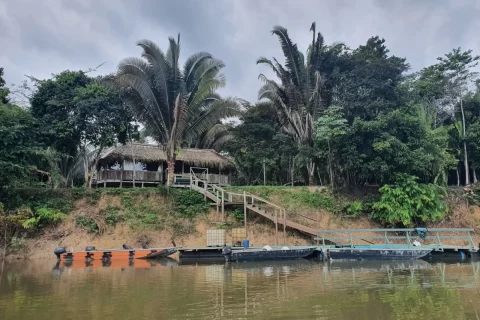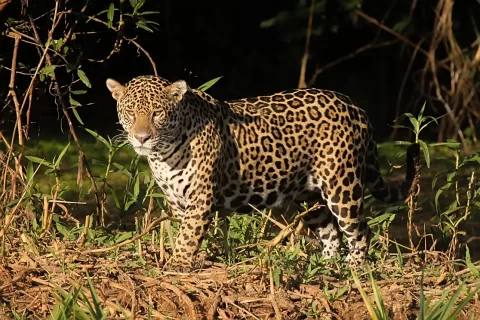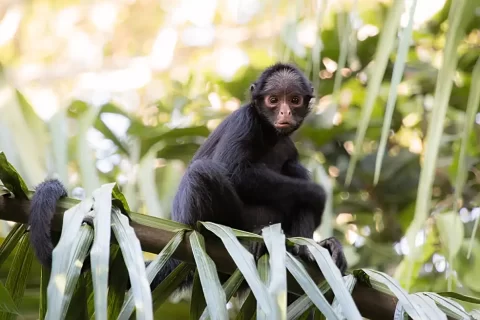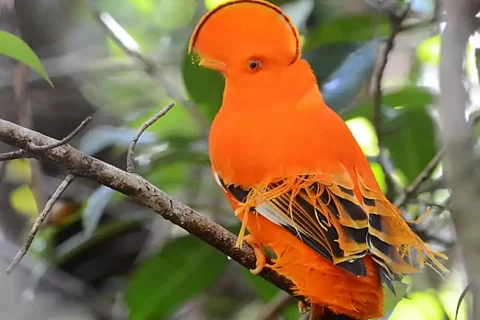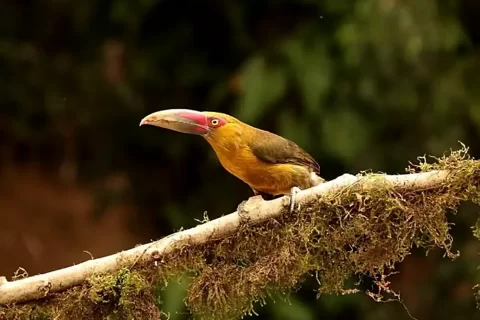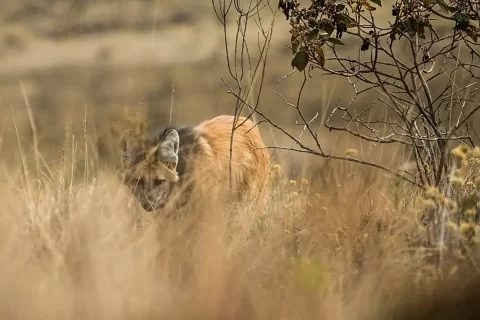Best time of year:
May – November
Duration:
7 or 8 days
Difficulty:
Medium. Forest birding, low light conditions and shy understorey birds. Some trails have steep sections.
Accommodations:
Good hotel in Porto Velho. The en-suite cabins at Pira Açu are rustic but have hot showers and air-conditioning.
Starts and Ends in:
Porto Velho
Tour Overview
Once the realm of rubber tappers during the early years of the 20th century, the middle reaches of the Aripuanã river are still flanked today by an endless carpet of pristine Amazon rainforest. Nowadays a few descendants of those rubber tappers still live in the region, subsisting on hunting, fishing, gathering Brazil nuts, and tapping the copaiba tree (Copaifera langsdorffii) for its essential oil. The PiraAçu Lodge was built to cater to sport fishermen, but the lodge is surrounded by many square kilometres of unbroken rainforest, home to some of the least known birds of the Amazon. The lodge is strategically located for its principal focus: aside from being situated on the right bank of the Aripuanã, one of the largest rivers in the Madeira-Tapajós interfluvium, from PiraAçu we have access to three other rivers, each with a different character and range of micro-habitats. Twenty minutes upstream from the lodge is the Paxiúba river, a relatively narrow left bank tributary of the Aripuanã with several small oxbows and associated seasonally flooded areas, along with mixed terra firme forest with patches of slender bamboos. Roughly 50 minutes downstream from the lodge we reach the Guariba river, a fairly wide left bank tributary of the Aripuanã flanked by tall forest on a wide floodplain, with a variety of seasonally flooded and transitional forests rich in vine tangles and patches of slender bamboos. The most secluded of the four rivers is the Buiuçu, a right bank tributary of the Aripuanã which can be reached either by a 25-30 minute boat ride downstream from the lodge, or by a two kilometre trail leading from the far end of the landing strip down to the river. Agami Nature Tours has been working with the lodge to develop a trail system, and during our first visits to the lodge we have recorded in excess of 400 species, including rarities such as Rondonia Bushbird, Nocturnal Curassow, Rufous Potoo, Crimson Topaz, Fiery-tailed Awlbill, Dark-winged Trumpeter, Zigzag Heron, White-browed Hawk, Pavonine Quetzal, Cryptic Forest-Falcon, Rufous-necked Puffbird, Black-girdled Barbet, Pearly Antshrike, Banded Antbird, Striated Antbird, White-breasted Antbird, Pale-faced Bare-eye, Alta Floresta Antpitta, Tapajos Antpitta, Rusty-belted Tapaculo, Hoffmanns’s Woodcreeper, Crimson Fruitcrow, Black-and-white Tody-Flycatcher, Buff-cheeked Tody-Flycatcher, Chico’s Tyrannulet, Klages’s Gnatcatcher, Musician Wren, Tooth-billed Wren, Red-and-black Grosbeak and Dotted Tanager.
Itinerary
Day 1: Arrival in Porto Velho.
Arrival in Porto Velho. You will be met at the airport for the transfer to a comfortable hotel with all modern conveniences in Porto Velho, the capital of the state of Rondônia. Depending on arrival schedules, there may be time for a bit of birding in the afternoon near Porto Velho.
Night at Slaviero Essential Hotel in Porto Velho.
Day 2: Fly to PiraAçu Lodge.
In the morning we take a chartered flight from Porto Velho to PiraAçu Lodge, a trip of about an hour and thirty-five minutes. As we leave Porto Velho behind, the man-altered landscape below us will gradually be replaced by swatches and then an entire carpet of rich green as we pass over unbroken forest en route to the lodge. It is impossible not to feel a thrill as our plane descends steadily over the Guariba river and its oxbow lakes before reaching the Aripuanã and the only scar on the landscape, the lodge’s landing strip. Lodge staff will meet us at the air strip, and we can either ride or walk the 500 metres from the landing strip to the lodge. After our first delicious lunch at the lodge, we can start in on the lodge’s list of more the 400 species of birds with a walk on one of the trails or a relaxing boat trip on one of the four rivers accessible from the lodge.
Night at PiraAçu Lodge.
Day 3 – 7: PiraAçu Lodge.
We have five full days to explore the area surrounding PiraAçu. Once the realm of rubber tappers during the early years of the 20th century, the middle reaches of the Aripuanã river are still flanked today by an endless carpet of pristine Amazon rainforest. Nowadays a few descendants of those rubber tappers still live in the region, subsisting on hunting, fishing, gathering Brazil nuts, and tapping the copaiba tree (Copaifera langsdorffii) for its essential oil. PiraAçu Lodge was built to cater to sport fishermen, but the lodge is surrounded by many square kilometres of unbroken rainforest, home to some of the least known birds of the Amazon. Our Agami Nature Tours guides have been working with the lodge to develop a trail system, and during our first scouting visits to the lodge we recorded in excess of 400 species, including rarities such as Rondonia Bushbird, Nocturnal Curassow, Rufous Potoo, Crimson Topaz, Fiery-tailed Awlbill, Dark-winged Trumpeter, Zigzag Heron, White-browed Hawk, Pavonine Quetzal, Cryptic Forest-Falcon, Rufous-necked Puffbird, Black-girdled Barbet, Pearly Antshrike, Banded Antbird, Striated Antbird, White-breasted Antbird, Pale-faced Bare-eye, Alta Floresta Antpitta, Tapajos Antpitta, Rusty-belted Tapaculo, Hoffmanns’s Woodcreeper, Crimson Fruitcrow, Black-and-white Tody-Flycatcher, Buff-cheeked Tody-Flycatcher, Chico’s Tyrannulet, Klages’s Gnatcatcher, Musician Wren, Tooth-billed Wren, Red-and-black Grosbeak and Dotted Tanager. During our days at the lodge we will mostly spend our time birding on trails in primary terra firme forest; some trails cross deep ravines and stream beds and accordingly have a few steep sections. We shall also bird a trail up to a hilltop with stunted campinarana forest with a different set of birds. We will bird by boat up and down four different rivers: the wide Aripuanã and Guariba rivers, and the narrower Paxiuba and Buiuçu rivers. Trails on the Guariba and Paxiuba access stands of bamboo where we’ll search for the Rondonia Bushbird, one of the Amazon’s rarest and least-known antbirds. The accommodations at the lodge are rustic but the en-suite cabins have 24-hour electricity, hot showers, and air-conditioning. The food is both copious and delicious.
Nights at Pira Açu Lodge.
Day 8: Return to Porto Velho.
We return by air to Porto Velho in mid-morning, arriving in time to connect with early afternoon flights departing Porto Velho.
End of tour.
Possible Extensions and Additions
Humaitá and Campos Amazonicos National Park
It is possible to reach Pira Açu Lodge overland, taking the Transamazonica Highway as far as the banks of the Aripuanã river where lodge staff would meet us with boats for the 2.5 hour trip upriver to the lodge. Since the overland route in its entirety takes approximately 12 hours from Porto Velho to the lodge, it makes sense to combine the lodge with a couple of days staying in Humaitá on the west bank of the Madeira river. Around Humaitá there are plenty of birding options, including the várzea forest along the first five kilometres of the Transamazonica on the east bank of the Madeira, the native grasslands surrounding the town and between Humaitá and Porto Velho, and the excellent tall forests found between Humaitá and Lábrea. Furthermore, we can also stay a night at the northern edge of the Campos Amazonicos National Park between Humaitá and the Aripuanã river to look for Aripuanã Antwren and Manicoré Warbling-Antbird, amongst others.
Please contact us for more details about this option.
Southwest Amazon Megas
PiraAçu Lodge is easily combined with part or all of our Southwest Amazon Megas tour to cover the range of specialties found west of the Madeira river. Please contact us for a customized itinerary.
Heart of the Amazon
It is possible to fly from Manaus to Apuí, the nearest town to the PiraAçu Lodge. From Apuí we travel 100 kilometres along the Transamazônica Highway to the banks of the Aripuanã river, where boats from PiraAçu await us for the 2.5 hour river trip upstream to the lodge. As such, the PiraAçu Lodge fits perfectly as a tour extension to our Heart of the Amazon tour.
The Pantanal
Adding a week in pristine Amazon rainforest makes for a wonderful combination with the Jaguars and birds of The Northern Pantanal. There are multiple flights daily between the cities of Cuiabá (start/end point for our Pantanal tour) and Porto Velho (start/end point for PiraAçu).










